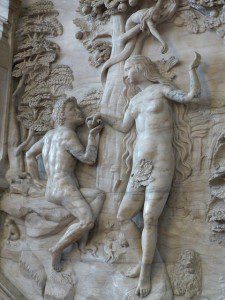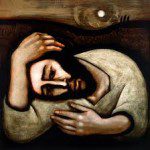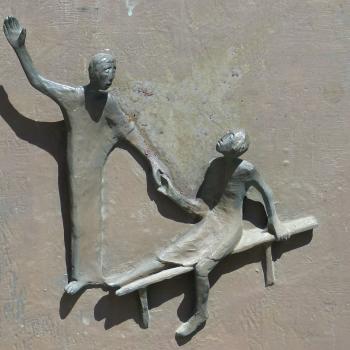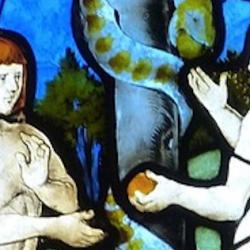Homo Sapiens, who developed about 200,000 years ago, could think, but could not think about thinking. That would come 150,000 years later with the arrival of Homo Sapiens Sapiens. Thinking about thinking involves language, which is the ability to manipulate symbols in the mind and then create external signifiers (e.g., words, gestures, writing). Soon Homo Sapiens Sapiens realized that they could experience altered states of consciousness by various practices e.g., dancing, drumming, chanting, fasting, enduring extreme pain or ingesting entheogens.
Among those altered states of consciousness, perhaps the most exciting were states of mysticism – the ability to experience and dialog with the gods. They quickly learned that this venture was fraught with danger; hence the caveat: “It is a terrible thing to fall into the hands of the living god.”
There were two main dangers – that of permanent madness (the inability to subsequently operate in the “ordinary” world) or inflation (a virulent form of narcissism.) So, very quickly, the elders set in place a bunch of restrictions to prevent the unprepared (uninitiated) from stumbling into such experiences.
We call these restrictions “taboos.” The first notion of sin, then, was the willful disregarding of these taboos. Was this, perhaps, the “sin” of Adam and Eve?
In later eras, sin would change its meaning fairly radically. The second understanding of sin, I believe, was that it involved failure to honor a covenant between a tribe and a god. The tribe operated as a “corporate singularity.” So, if one member sinned, the whole tribe was guilty and needed to be punished. For the “non-offenders” to protest their innocence would be the equivalent, today, of a murderer pleading that since it was only his index finger that pulled the trigger, only it needed to be punished and the rest of him should be set free.
This idea of punishing all for the sin of one has a long history; according to Genesis chapter 3, all of humanity was to be punished for the sin of our first parents. Even today, we kill millions of innocent civilians in order to punish the sins of political dictators e.g. Panama, Iraq, Syria…
The third phase of sin was the notion that it was the breach of a commandment. Beginning with the Code of Ur-Nammu in Mesopotamia around 2100 BCE, the law of Moses around 1250 BCE and the Brehon Laws of the Irish, each culture created or received via “divine revelation” a law-code that legislated all aspects of private and public life. The infraction of any of these led to the punishment of the individual sinner (and, sometimes, his progeny.) This punishment was either meted out directly by the offended god or by his earthly representative – the king or the priest.
This phase is still alive and well on planet Earth and is, currently, most violently represented by ISIS and fundamentalist Islam, which is outraged on behalf of Allah, and quite prepared to chop off limbs and heads to satisfy Allah’s rage at his subjects’ disregard for his laws.
Personally, however, I believe that the only sin is the selfish decision or utter laziness to stay asleep rather than do the work of aspiring to enlightenment. Infractions of precept or breaches of covenant are simply epiphenomena that flow from this lethargy.
Having created the above general outline, I now want to do a review, in rough chronological order, of how various cultures and religions have treated “sin.”
(A) The Sumerians
Civilization began with the Sumerians around 5,800 years ago. They gave us science, astronomy, writing, mathematics, marriage, divorce, adoption, taxes, religion… They claimed, however, that all of these were gifts brought from heaven by ET beings called, “The Anunnaki” who arrived on the planet about 445,000 years ago and genetically modified a hominid group, thus creating Homo Sapiens. Later, they genetically upgraded Homo Sapiens to Homo Sapiens Sapiens, giving him language skills. Then, although it was against their own law, they interbred with Homo Sapiens Sapiens, thus creating the demi-urges or “sons of god.”
So, strictly speaking, they didn’t create us but merely modified us into their own “image and likeness” – which is both good and bad news because not only did we pick up many of their skills, we also demonstrated an ability to be just as warlike.
According to Sumerian stories, having fashioned us to be a slave species (miners, gardeners, house servants…) they later pressed us into military service in their frequent internecine squabbles. And we learned that lesson really well.
When we failed to obey their rules, there followed immediate punishment. And, finally, in exasperation at our inability to live lawful lives, they determined to wipe us all off the face of the Earth in a global flood. And they damn near succeeded.
(B) The Hebrews
Because of the nearly ubiquitous availability of the Bible, this is probably the ancient civilization we most know about. Judaism went through several main eras. Firstly, a polytheistic phase – from Adam to Moses; secondly, a monolatry phase – from Moses (1250 BCE) to the Babylonian Exile (587 BCE). Monolatry is the belief that many gods exist, followed by a decision to worship only one of them. Thirdly, Judaism entered its monotheistic era after the return from Babylon (529 BCE) where they had come under the influence of Zoroastrianism.
The first era is characterized by a group of gods (the Elohim) who have a discussion about “making man in our own image and likeness.” Once again, that image is a two-edged sword since these gods demonstrate the same proclivity to anger, jealousy and bloodshed that the Anunnaki did.
These gods gave laws and punished the “first sin” by throwing Adam and Eve out of paradise and telling them that neither they nor their offspring were welcome back.
However the sons of these gods found the daughters of men to be very attractive and began to take them as wives, producing in the process a race of giants called the Nephilim or Anakim.
During the time of Moses, one of these gods, Yahweh, decided to make a covenant with the descendents of Jacob. An agreement of 613 laws was drawn up and Yahweh promised to give them a land flowing with milk and honey, if they would agree to worship only him.
One of the 613 precepts said, “Thou shalt not kill”, yet this god personally killed 371,186 humans and mandated that the Hebrews kill another 1,862,265 of their enemies. All in all not a very exemplary divinity.
Post-Babylonian monotheistic Judaism came to the following conclusions: God is one, God is just, there is no afterlife, and therefore behavior has to be rewarded or punished here and now. All suffering is the result of personal or parental sin.
(C) Zoroastrianism
The prophet Zoroaster reduced the polytheistic pantheon to just two divinities: Ahriman – the god of darkness; and Ahura Mazda – the god of light. Suffering and sin are the result of their cosmic battles. The Book of Job, in the Hebrew scriptures and also the Essene movement within Judaism were very heavily influenced by Zoroastrianism. As was John’s Gospel in the New Testament.
(D) The Greco-Roman World
These cosmologies also gave us creator gods – arranged in a strict hierarchy. Made in their image, we imitated their promiscuous behavior and warlike actions. They, also, had sexual intercourse with their human creatures, giving rise to a race of demi-gods. Like the Sumerians and Hebrews before them, these gods crafted, taught, imposed and applied laws, and punished any infractions with great anger. All human suffering was caused either as a direct punishment for our sins or, merely, as collateral damage during one of their own spats.
(E) Christianity
Once again, intercourse between God and a human woman (Mary) results in a divine child – this time, not a demi-god but a fully divine and yet fully human figure called Jesus. This is the Christian mystery of three persons in one God, but two natures (divine and human) in one of these persons.
St. Paul asserts that sin and evil are of three sources. Firstly, Law. He says that there was no sin before there was law. Secondly, The Flesh: “the good that I would, I do not; it is the evil I do not want that I find myself doing.” Thirdly, Extradimensional Beings: “For our struggle is not against human opponents, but against….cosmic powers….and evil spiritual forces in the heavenly realm.”
It would be left to Augustine, who lived around 400 AD, to invent “original sin” – not to be confused with the “first sin” of Adam and Eve. Rather, original sin was the indelible blemish imprinted on the newborn soul at the moment of conception by the ungodly act of orgasm. The results of this sin, said Augustine, were that our wills are weakened, our intellects are darkened and our bodies are subject to sickness and death. And Christianity bought that preposterous supposition. The West, and fundamentalist religion in particular, has maintained this simultaneous fascination and demonization of sex.
For good measure – just to be sure to be sure – the Catholic Church added a few more hell-meriting sins e.g., missing mass on a Sunday or eating sausages on a Friday. It’s a minefield out there!
(F) The East
More interested in mysticism than dogma, the East (especially Hinduism and Buddhism) added some very interesting dimensions: Sin is “Maya” – the illusion of believing and acting as if only the physical world is real; karma – the law of cause and effect – as a feedback loop that leads to enlightenment; and reincarnation as the compassionate cycle of getting as many chances as are needed to reach full alignment with Source.
Detachment is realizing the impermanence of pleasure and power. And Anatma (no-self) allows us to distinguish between pain (the price of incarnation) and suffering (the price of identifying with the ego).
The ultimate “sin” is choosing to remain unaware, and the chief virtue is buddhahood – being fully awake.
In the East, also, divine beings i.e. Devas (the good gods) and Asuras (the evil gods) manage to intervene and interfere and mate with humans.
(G) The National Security State
In this Alice-through-the-looking-glass system, good and bad are turned on their heads, in the service of the newest and most powerful of the gods, the National Security State.
If you kill somebody in Texas, you get executed, but if we put you in uniform, give you a gun and send you to Afghanistan, where you kill lots of people, we give you a medal.
If you tell lies in court, you get jailed for perjury; but if you tell lies on the campaign trail, you get elected to Congress. In fact we spend billions of dollars each year on the 3-letter agencies (CIA, NSA…) so they may invent spurious propaganda and assassinate democratically elected foreign leaders, topple governments and destabilize entire regions of the world.
If you cheat on your taxes or rob a 7-11, you get years of jail time, but when the banksters collapsed the national economy in 2008, the crooks were too big to jail.
So Satan and Source have reversed their roles. Up is down and virtue is unpatriotic. Like Yahweh of old, the National Security State promises to be our loving protector but then proceeds to turn all of its own precepts on their head.
Conclusion
In brief, the main sources of sin/evil appear to be of two kinds. Firstly, our relationships to the gods and, secondly, the battle between the soul and the ego. As far as the gods (and this includes the National Security State) are concerned, this includes the danger (taboo) of encountering them, agreeing to covenants with them, accepting their laws, interbreeding with them, realizing that we are built in their image, and being collateral damage in their interpersonal conflicts.
As for the ego-soul battle, it is the illusion (Maya) that keeps us asleep, the seductions of the flesh (pleasure and power seeking) and the cycle of karma that aims at restoring the balance.
It’s easy to come to the conclusion that the gods represent a very mixed blessing. Perhaps it’s because we have really created them in OUR image and likeness?













